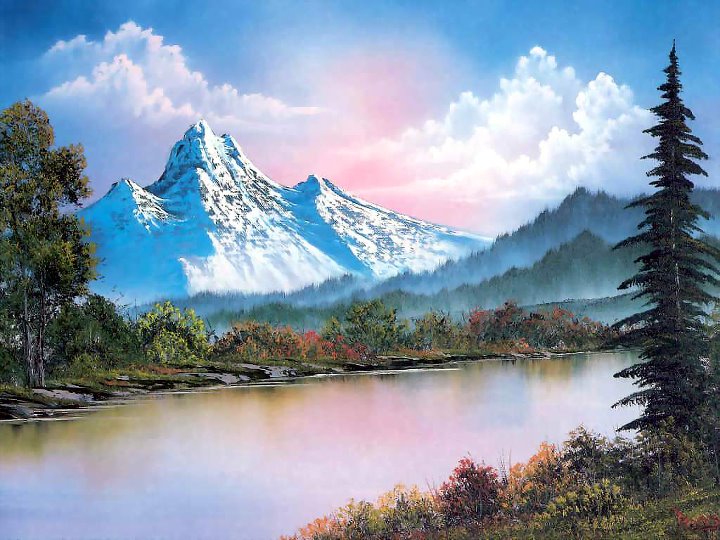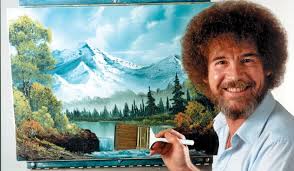The Bob Rossessaince: How Twitch is changing how art is perceived and created
Last week, Twitch.tv ran a special promotion, airing all episodes of The Joy of Painting in a multi-day mega-marathon. Over 3 million people tuned in to watch the event and the stream had as many as 70,000 concurrent viewers at times. Considering Twitch's age constituency, it's a mystery why this stream was so successful. The average twitch user is 21 years old, suggesting the main core of users is the typical 18-25 male demographic most commonly associated with serious gaming. Bob Ross's show ran from 1983 to 1994, which means that most millennials would be too young to remember the show. While, yes, there are twitch viewers in their 30's and beyond, they don't make up enough of the overall population to explain the phenomenon we witnessed last week. This means that The Joy of Painting has connected with a new, younger audience. Let's explore why.
How is it that a decades-old show with a deceased host has managed to capture the imaginations of a younger generation? The content is not the issue. While slightly dated from a technical standpoint(480 for life), Ross's painting skills and charming mannerisms have not lost their ability to captivate. It's obvious that Bob Ross can connect with anybody with a goddamn soul, so it was just a matter of helping the younger generation discover The Joy of Painting.

The Rossessaince began about half a decade back when the Bob Ross brand created Facebook, Twitter, and YouTube accounts. Slowly, Bob Ross's social media presence grew, most likely initially relying on nostalgia from older users on established social media. However, slight mismanagement kept The Joy of Painting from reaching newer eyes. The Bob Ross YouTube channel hadn't uploaded a single full episode in four years, choosing only to post 30 second clips of episodes. After no YouTube activity for three years, the channel began uploading full episodes about seven months ago. Whether this was purposeful, or a happy accident, the move immediately paid dividends, skyrocketing the average number of views per video from under 5,000 to about 1 million. Recognizing the success of this strategy, the Bob Ross YouTube channel has been steadily putting up full episodes ever since, making us all happy little viewers.
I believe that this shift in YouTube strategy, coupled with existing social media presence, created the momentum which lead us to the Twitch.tv phenomenon. I think by demonstrating the potential for great success on newer media platforms, the Bob Ross brand was given the greater opportunity to help launch Twitch Creative. In migrating The Joy of Painting from basic cable to a more modern medium, the series has gained new life and a new fanbase.
![]()
Bob Ross's new lease on life due to Twitch has repercussions that reverberate farther than just the Alaskan landscapes in his paintings. While Bob Ross is deceased and therefore cannot interact directly with his viewers, his conversational and personal style of speaking caught on with the Twitch community, manifesting in spams of "RUINED" and other such reactions to his paintings. While most of Twitch chat devolves into silly emotes or spamming simplistic messages, the messages themselves aren't important - it's the communal participation and sense of belonging that is achieved by so many people spamming known catchphrases. The strength of this community lies in its ability to influence the medium being streamed - either directly or indirectly.

What do I mean by this? Well, in the case of The Joy of Painting marathon, we have a painting show that ran its course 20 years ago. None of the episodes were broadcasted live or had any audience interaction, but an entirely new way of experiencing the show developed within the communal chat feature on Twitch.tv. Through spams of "GLHF" at the start of an episode, "VAC" (a counter-strike term) after a nice stroke, or "GG" after Ross signed a painting, the Twitch community quickly created a narrative equating the painting show to the games typically played on Twitch.

Twitch chat also has the ability to influence artists directly. A couple years back, I was involved in a Kickstarter for a game I was working on, Spark Rising. To generate hype, our team decided to stream game development for 48 hours straight on Twitch. We had our artist do some live concept art while taking suggestions from the chat and the result was a very funny, collaborative experience. While it's obvious that the nature of streaming and constant interaction through social media has the ability to alter the way that we perceive art, now we're starting to see how these new interactions are changing the way that art is created. The result is an entirely unexplored space where creator and audience are in a constant dialogue. I can't even begin to speculate on the possibilities, but it's certainly going to be an interesting future!


Leave a Reply